Soldiers train for WMD raids
“GAS! GAS! GAS!”
The shouts echo up a dimly lit stairwell. Soldiers hastily wrap their faces in gas masks—the only thing protecting their lungs from a deadly, weaponized poison.
American troops are raiding a nuclear facility and they’re looking for weapons of mass destruction.
The soldiers don’t know the full extent of it. But the armed occupants are using the facility as a lab to engineer chemical—and possibly nuclear and biological—weapons.
Gunfire and shouts reverberate throughout the building as the assault team moves, and as the opposition shoots back.
The Americans capture several scientists and interrogate them—as the troops try desperately to find the location of weapons and sensitive documents, all the while dodging enemy booby-traps.
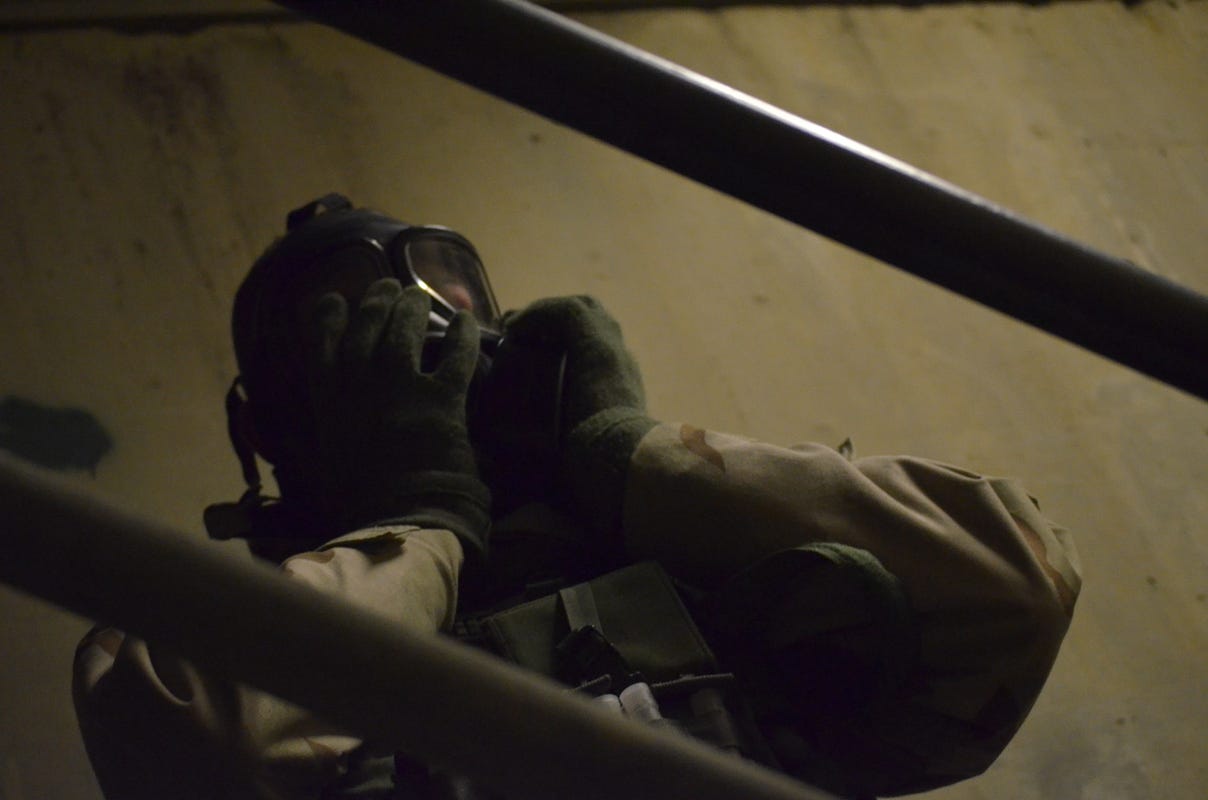 At top—a soldier in a gas mask pulls security during an exercise at Satsop Nuclear Power Plant. Above—Soldiers don gas masks. Kevin Knodell photos
At top—a soldier in a gas mask pulls security during an exercise at Satsop Nuclear Power Plant. Above—Soldiers don gas masks. Kevin Knodell photos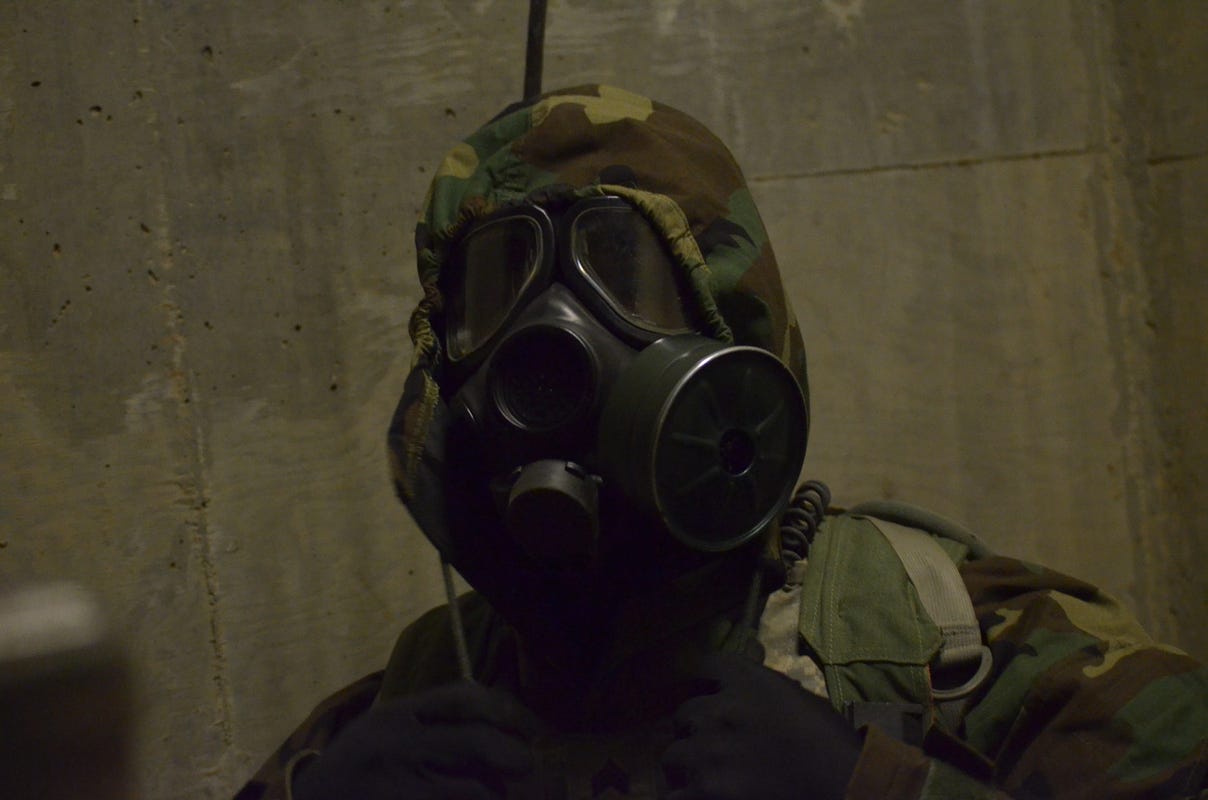
Luckily, this nightmare scenario isn’t real. It’s a military training program played out on Nov. 12 as part Gryphon Longsword—an exercise held at the never-completed Satsop Nuclear Power Plant in Washington state.
Gryphon Longsword is a joint endeavor between military intelligence, infantry, chemical warfare, and Special Forces troops based at Joint Base Lewis-McChord. The focus is on learning how to fight and work together in a contaminated environment.
Despite he bloody invasion of Iraq to shut down Saddam Hussein’s non-existent weapons of mass destruction program, the issue of chemical, biological and nuclear proliferation is still very much on the Pentagon’s agenda.
In 2006, North Korea became a nuclear-armed state after a successful weapons test, and Pyongyang since declared it’s producing nuclear warheads. The United States has also accused Iran of developing nuclear weapons under the guise of a domestic energy program.
On Aug. 21, 2013, the Syrian regime of Bashar Al Assad killed hundreds of people with Volcano rockets packed full of sarin, a deadly nerve gas.
With all these weapons out there, the Army wants its soldiers to be aware of the unique dangers of operating in an environment where an enemy could use these weapons against them.
The soldiers in the exercise admit they don’t know whether they will encounter a scenario like this, but they also can’t be sure they won’t.
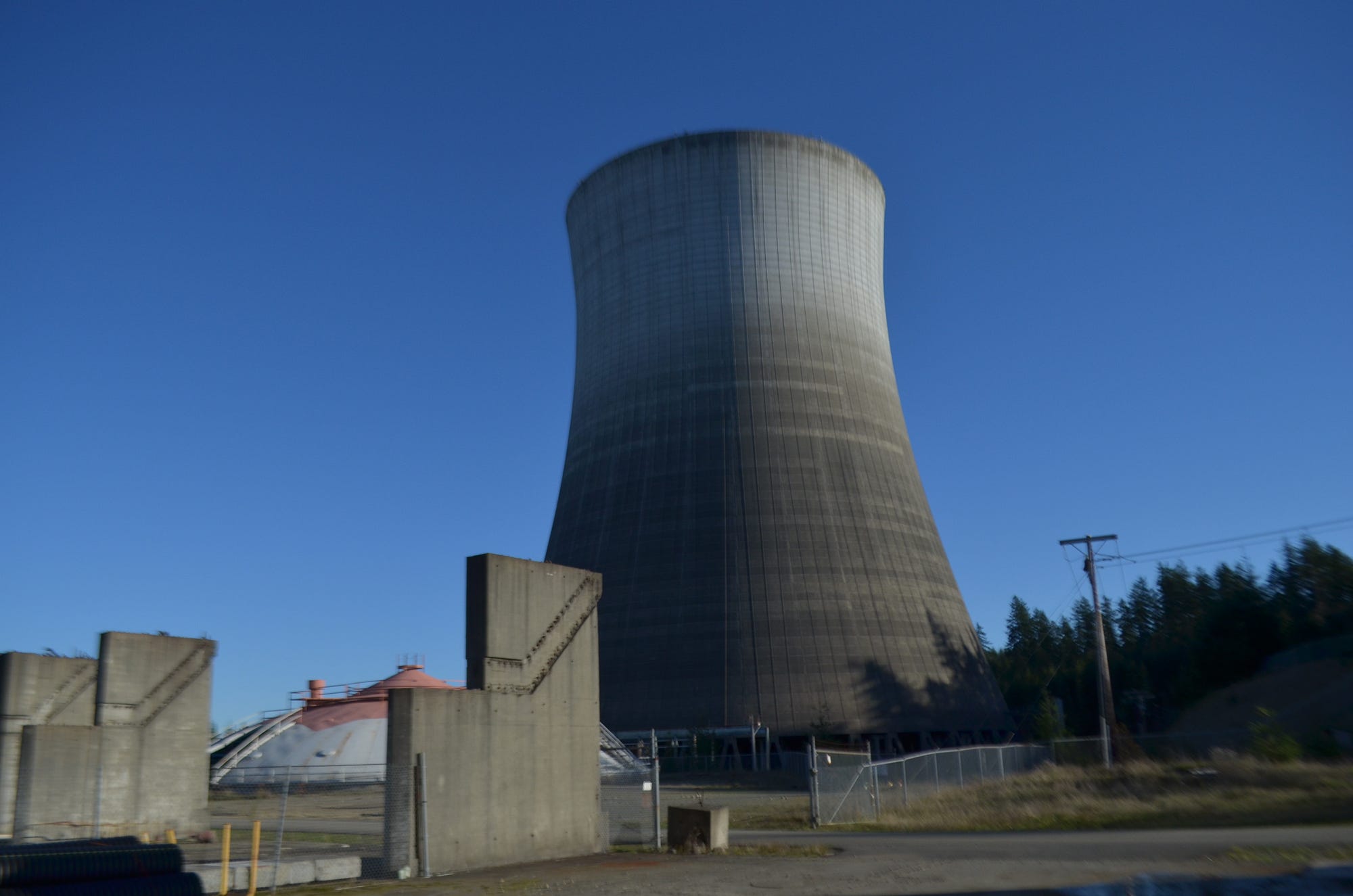 Satsop Nuclear Power Plant. Kevin Knodell photo
Satsop Nuclear Power Plant. Kevin Knodell photo
Battling inside a nuclear reactor
Construction of the Satsop Nuclear Power Plant began in 1977. It was to be the largest nuclear power project in American history. The site was 75 percent complete in 1983 when the money ran out.
By then, American public opinion had swung sharply against nuclear power after the Three Mile Island disaster. The state decided not to fund the project further, and the site remained unfinished.
Thirty years later, the area is now a business and technology park in the shadow of two massive, inactive cooling towers. But the site, killed by America’s fear of nuclear power, found new life thanks to America’s fear of nuclear and chemical weapons.
Since 2005, the Army has used the site to train soldiers for operating in hazardous environments—and for learning how to clear buildings room to room. Gryphon Longsword focused on the complex’s large reactor building.
The labyrinth of hallways, stairs and rooms snake deep under ground—an ideal environment for ambushes. The corridors of the facility look like a level from Half-Life. It’s incredibly difficult to navigate. And that’s why the Army loves it.
“It forces soldiers to think,” says Lt. Col. Justin Haynes, commander of the 502nd Military Intelligence Battalion.
His soldiers are among those taking part in the exercise. “It’s not like anything they’ve seen before.”
 Above—Soldiers lay out simulated IEDs and booby traps. Below—soldiers set up simulated laboratories and offices. Kevin Knodell photos
Above—Soldiers lay out simulated IEDs and booby traps. Below—soldiers set up simulated laboratories and offices. Kevin Knodell photos
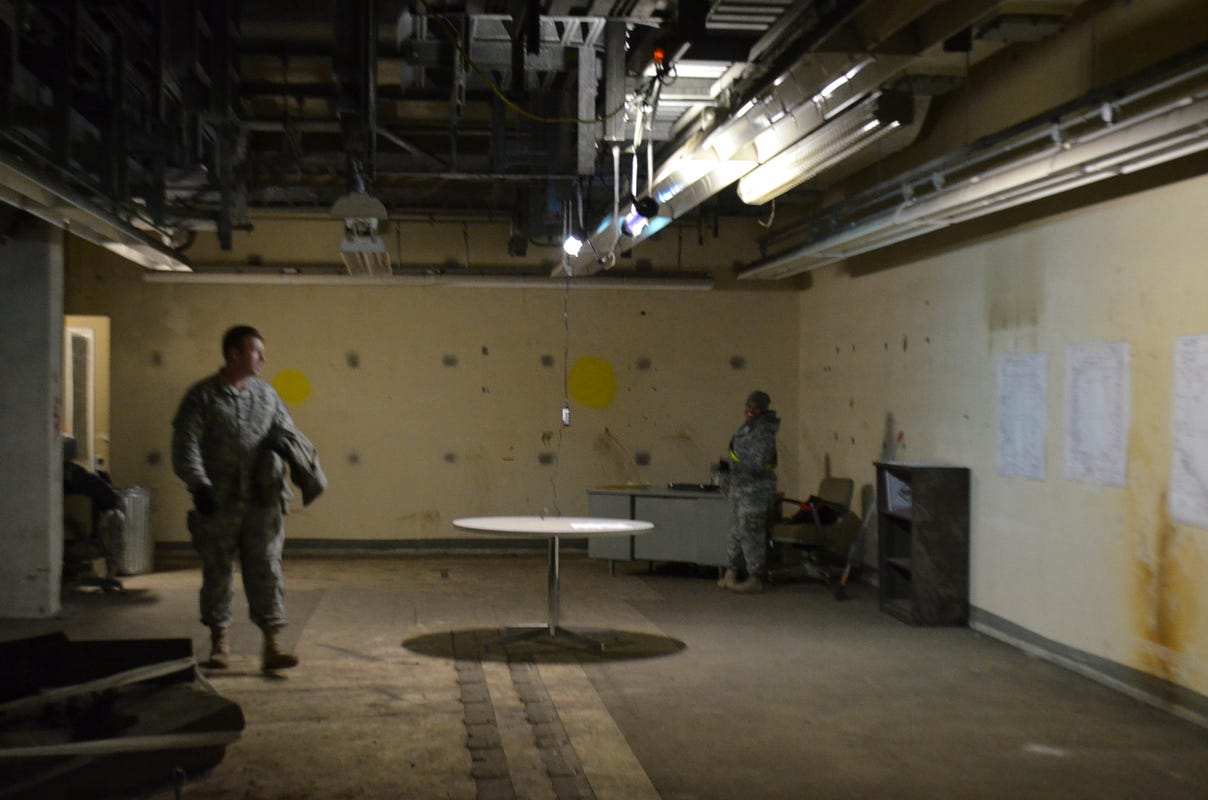
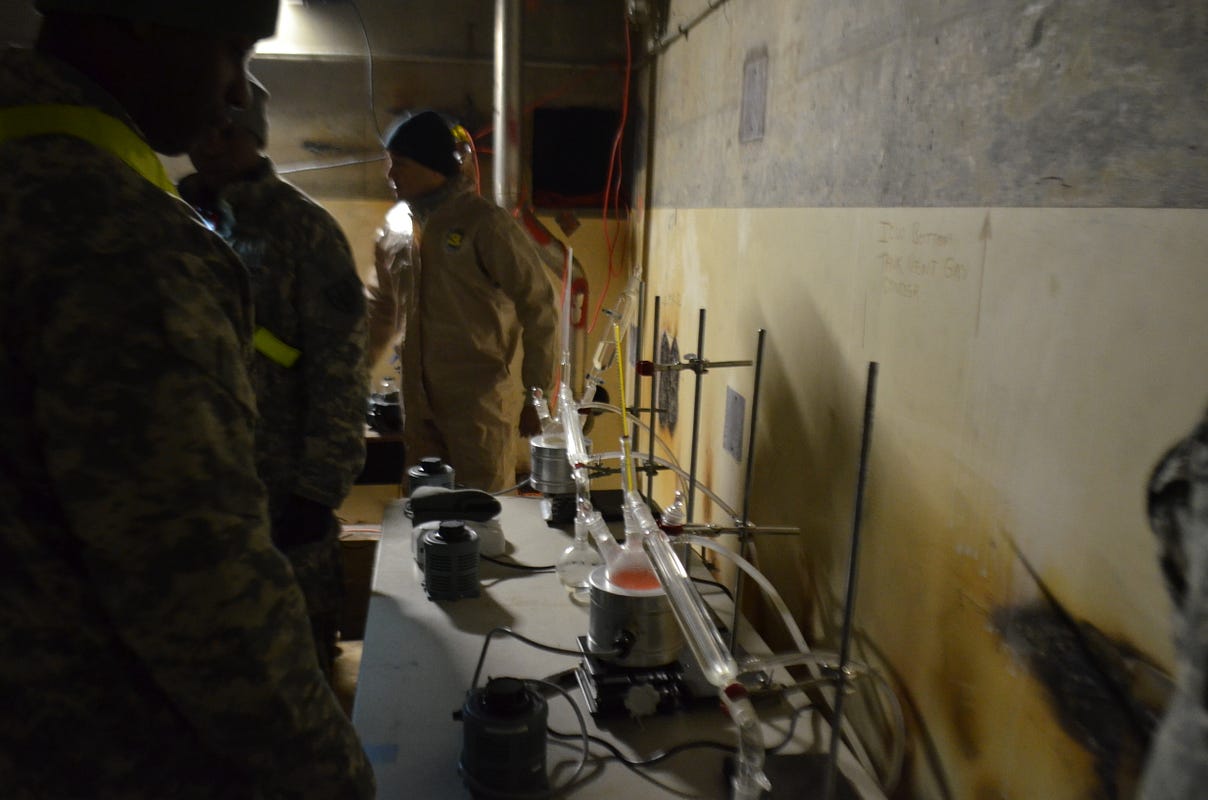
Before helicopters arrive to drop off the assault teams, soldiers at the site adopt the role of civilians and the armed opposition. They set traps and plant documents—critical intelligence items the attacking soldiers will need to discover to learn about what’s happening inside the facility.
Civilian scientists play an important role in the exercise. According to the scenario, the enemy guards are forcing the scientists to produce weapons against their will—and the guards have already killed several scientists for refusing.
At first, the cartoonishly evil villains makes the situation seem a bit simplistic, but it really makes the scenario far more complex. The soldiers need to take extra care not to kill the potentially helpful scientists. Many of them have valuable intelligence. It’s important for the soldiers to avoid going into every room with guns blazing.
Chief Warrant Officer Christopher Dawson of the 555th Engineer Brigade’s 110th Chemical Battalion helped set up the exercise. He’s also there to observe the training and dispense advice.
“We’ve never done this before,” he says, as he and other soldiers wait for the helicopters to drop off the first batch of attacking troops.
He explains that joint operations involving chemical troops, regular infantry and military intelligence are rare. Getting so many soldiers with different specialties and jobs to work together well in the same space is a challenge.
“Sounds like a cluster to me,” one sergeant remarks.
“That’s why we’re doing this” Dawson replies. Making something like this work takes practice.
 Soldiers secure the facility. Kevin Knodell photos
Soldiers secure the facility. Kevin Knodell photos


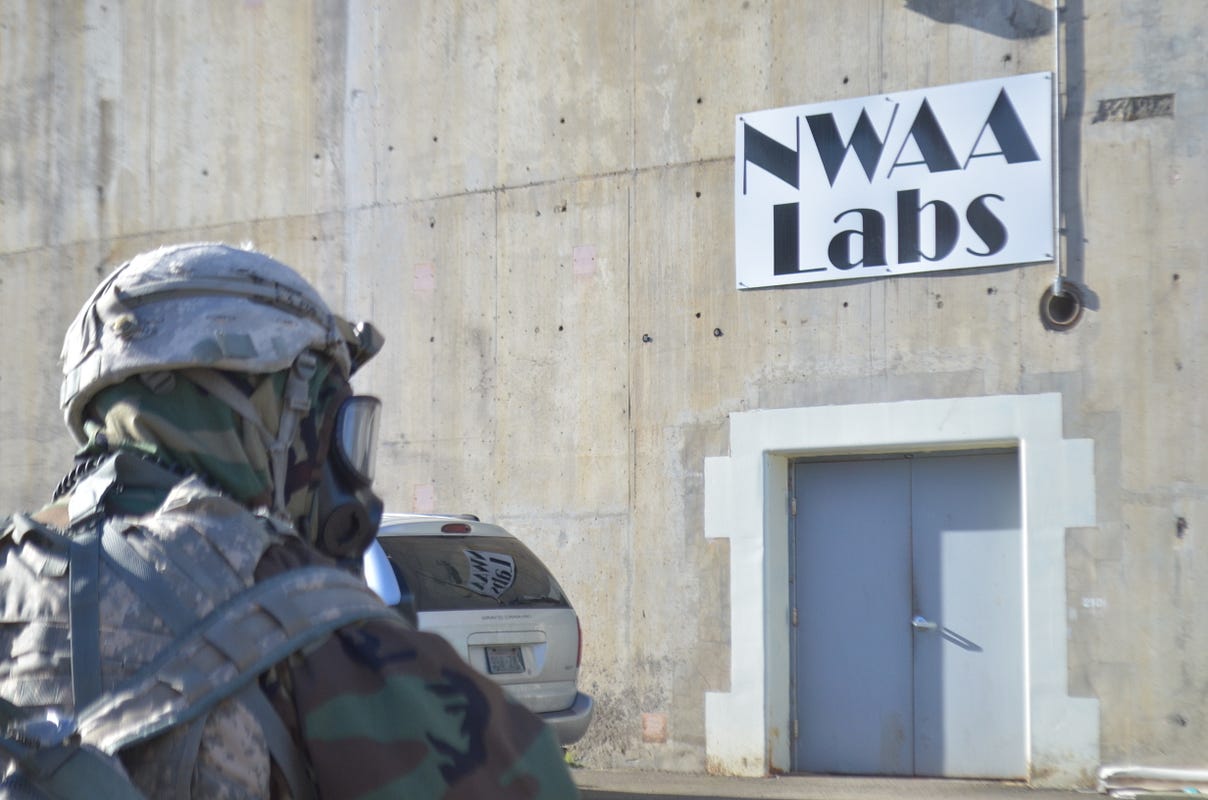
As Chinook helicopters land, soldiers immediately get out and start securing the facility, beginning with several nearby buildings. They search for weapons, detain and question a few suspects, and then move closer to the reactor.
During a firefight with a group of opposition troops, the soldiers see smoke. They don’t know if it’s coming from a smoke grenade or a chemical weapon.
The soldiers need to be constantly mindful of the direction of the wind. Dawson explains that in a chemical environment—where a change in wind can mean gas blown toward a friendly troop formation—paying attention to such small details is the difference between living or dying.
As the soldiers move into the main building, the exercise becomes increasingly chaotic. It’s dark, so the soldiers must rely on flashlights. They move carefully down creaky, pitch-black metal stairways.
After the infantry clear the rooms and capture guards and scientists, the intelligence troops pick through objects and begin interrogations.
 At left, soldiers move cautiously down a dark hallway, at right, a military intelligence soldier takes notes on what they’ve found during the operation. Kevin Knodell photos
At left, soldiers move cautiously down a dark hallway, at right, a military intelligence soldier takes notes on what they’ve found during the operation. Kevin Knodell photos
As the assault teams move deeper into the facility, they discover their radios are no longer reliable. They’ve brought a telephone with a long cord to communicate in the facility, but they largely depend on runners to relay information.
Lt. Col. Jeff Bryson, the battalion commander of the infantry troops, observes the exercise. He has a scowl on his face.
He notices group of soldiers watching another team go down a stairway.
“I see a lot of people just standing around,” Bryson shouts.“Lets try pulling security, you know? Like you’re in the Army!”
As the soldiers reach the bottom floor, the enemy troops—clad in protective chemsuits of their own—release a cloud of gas. The soldiers put on their gas masks. The gear diminishes visibility and makes verbal communication much more difficult.
For the soldiers, it’s disorienting.
Muzzle flashes illuminate the dark hallways as soldiers make their way forward, clearing rooms as they go. They find an animal testing room and a lab for producing nerve gas—and they capture several scientists.
Although simulated, the fighting is fierce. The temperature is near freezing, but the soldiers are boiling in their heat-trapping protective suits.
Staff Sgt. David Kinsler triggers a trap near the end of the exercise, as other soldiers capture the chief scientist. Kinsler and a fellow soldier are the final casualties.
He says he’s accustomed to training in much simpler settings, with walls made of plywood and makeshift materials. The large facility is a big change for him. Kinsler also notes he hasn’t worried about wearing a chemsuit and gas mask in more than a decade.
“I haven’t cleared in a full chemsuit since 2003,” he says.
Kinsler fought in the initial invasion of Iraq.
Lt. Col. Jeff Bryson advises an officer during the exercise. Kevin Knodell photo
Chemicals in the real world
When the U.S. invaded Iraq in 2003, the Pentagon told commanders to be ready for anything—from radiation to deadly nerve agents. The soldiers of the expeditionary force wore protective suits to shield themselves from poison gas, nerve agents and bio weapons.
They donned gas masks as they searched suspected WMD caches. It was an absolutely miserable way to fight a war in the desert.
They did find scattered chemical and biological shells as they secured some Iraqi facilities. The problem is that none of them were part of any activeweapons program—the main justification for the entire war.
They found nothing to suggest any active, large-scale program. As American troops moved into Baghdad and secured surrounding areas, the soldiers stopped wearing their protective gear.
But in October, New York Times reporter C.J. Chivers revealed that American troops in Iraq found chemical weapons on a much wider scale than previously reported. U.S. forces encountered thousands of chemical and biological munitions.
Many were American-designed weapons, produced in Europe and exported to Iraq to fight Iran on the West’s behalf.
At that time, Western states actively helped the regime obtain and produce chemical weapons. Hussein used these weapons both against the Iranians, and against his own people to quell uprisings. Ba’athist forces used these weapons in the massacre of the Kurdish town of Halabja, the single most lethal chemical weapons attack to date.
Showing the world those weapons would have been an embarrassing reminder of a chapter of history the Pentagon—at the time headed by Donald Rumsfeld, a central figure in U.S.-Iraqi relations during the Reagan administration—didn’t want to discuss.
As a result, officials did everything they could to suppress information about these weapons. And not just from the press.
The U.S. government chose not to tell coalition troops—even commanders—that these weapons were out there and dangerously unstable.
Many soldiers—including ordinance disposal experts—unknowingly handled chemical munitions and developed strange symptoms. Medical personnel never briefed on the possibility of chemical casualties didn’t know what to do.
In some cases, Army doctors accused afflicted soldiers of using drugs or lying about symptoms, until tests confirmed they’d indeed been in contact with dangerous poison agents. Officials ordered everyone involved—both the victims and the doctors that treated them—to tell no one.
On June 10, as Islamic State militants expanded their war and swept through northern Iraq, they took control of Al Muthanna, a facility that Iraqi officials reported held stockpiles of sarin shells and other agents. The news caused alarm—many fear the militants will take possession of the munitions and use them.
But just because Islamic State can get them, that doesn’t necessarily meanthe weapons are still useful. Deploying them as artillery is pretty much out of the question. Even re-purposing shells could be dangerous for militants handling them, as the shells are highly unstable.
But in many ways, that doesn’t matter. Efficiency isn’t necessarily the goal with chemical and biological weapons.
 At left—a soldier gives instructions through hand signals. At—right a soldier playing the plants’ chief scientist—the “Mad Chemist”—surrenders to U.S. troops. Kevin Knodell photos
At left—a soldier gives instructions through hand signals. At—right a soldier playing the plants’ chief scientist—the “Mad Chemist”—surrenders to U.S. troops. Kevin Knodell photos
“There’s a difference between weapons of mass destruction versus mass disruption,” a member of the 1st Special Forces Group’s Chemical Recon Detachment tells War is Boring.
The CRD is a small team tasked with searching for and evaluating chemical weapons threats. The unit, like most of the units participating in the exercise, is primarily trained to operate in East Asia and the Pacific.
“Most of what we see [in Southeast Asia] is small scale, clandestine operations,” he says.
He explains there are many areas in the region that are hard to monitor. He said that when terrorists and extremists improvise chemical weapons, they usually aren’t meant to tip the scales of any battle—it’s more for the psychological impact.
Namely, chemical weapons can wreak havoc on civilian populations, contaminate drinking water and crops—and generally kill lots of people.
The soldier says he considers that scenario to be the most likely real-world use for these weapons. But he doesn’t rule out the possibility of a large-scale WMD operation—checking himself as that may just be because that’s what his training and experience tell him.
“I might just think that way because that’s what we train to do,” he adds.
The CRD had trained during a similar exercise at Satsop a week earlier, coordinating with an infantry unit. “It was different for us,” the soldier said. He noted the CRD normally works with other Special Forces troops. He said they rarely work with “the big Army.”
He says that’s useful experience. If the CRD were in the field and found a facility like this, clearing it would be outside the scope of what they could realistically deal with.
“A facility this size we couldn’t take by ourselves,” he explains. “We would have to call in for backup.”
Soldiers fight for the bottom floor. Kevin Knodell photos

Capt. Chris Pursel, the officer in charge of planning Gryphon Longsword, says the focus of this exercise is definitely the big stuff—large-scale operations and fighting other armies.
“This is about getting back to basics,” he says, explaining that soldiers need to prepare for “peer-to-peer” fights against a conventional army.
One of the most likely flash-points that could involve WMDs and conventional armies is the Korean Peninsula. The North Korean regime has already successfully tested nuclear weapons and wants to have more—something that excites absolutely no one in the region. Even North Korea’s historic buddy China is deeply uncomfortable with Pyongyang’s nuclear program.
Chinese generals have even talked about preparing for a “nuclear disaster” in the northeast. Though its erstwhile ally has not been specifically named, Beijing is afraid of both Pyongyang’s belligerence and the questionable quality—and safety—of its nuclear projects.
North Korean defectors have also told stories of biological and chemical weapons programs, including allegations of horrific weapons testsconducted on political prisoners. The regime allegedly currently produces sarin, hydrogen cyanide and mustard gas along with a host of other deadly agents.
Pyongyang also exports both knowledge and equipment. According to a2012 Pentagon report to Congress, South Korean authorities seized a shipment of North Korean made chemical warfare protective suits bound for Syria in October 2009.
And in 2012, a defecting Syrian army major—who claimed to be an officer in the chemical warfare corps—told Syrian newspaper Zaman Alwsl that North Korean and Iranian military advisers were helping the regime with offensive chemical weapons.
With the facility clear, the soldiers move back to the surface. They gather their equipment and their prisoners, and prepare to head back to their rendezvous point for the helicopters to take them home.
As the soldiers form up at the facility entrance, Bryson opens up for a chat. He’s relaxed. He says despite being hard on his troops as they moved through the facility, he thinks they did incredibly well.
He explains that having so many soldiers—and different kinds of soldiers, at that—work together in such a complex environment is difficult, in the best of circumstances. Toss in chemical weapons conditions, and any hopes of doing things perfectly are over.
“It’s a mess. A hot mess,” Bryson says.
The Special Forces soldier explains it’s useful to see how other units think and do things. “There’s a lot of things the big Army does well, and not so well, just like us,” he said.
He adds he thinks that Special Forces troops should be open to learning from regular soldiers. He also says the experience gives him a better understanding of how hard it is for large units to operate.
Pursel, the simulation planner, observes that the soldiers did much better than the previous week’s exercise. They learned how to better communicate through their protective gear, and paid closer attention to their surroundings. But there’s always room for improvement, he says.
It’s hard to really simulate the horror of chemical warfare. In this scenario, the soldiers were in and out in a matter of hours, and will head home that day.
Another soldier with the 1st Special Forces Group says that in real life, the operation would take days, if not weeks or months to truly clear a facility like this.
“To do it right.”


No comments:
Post a Comment